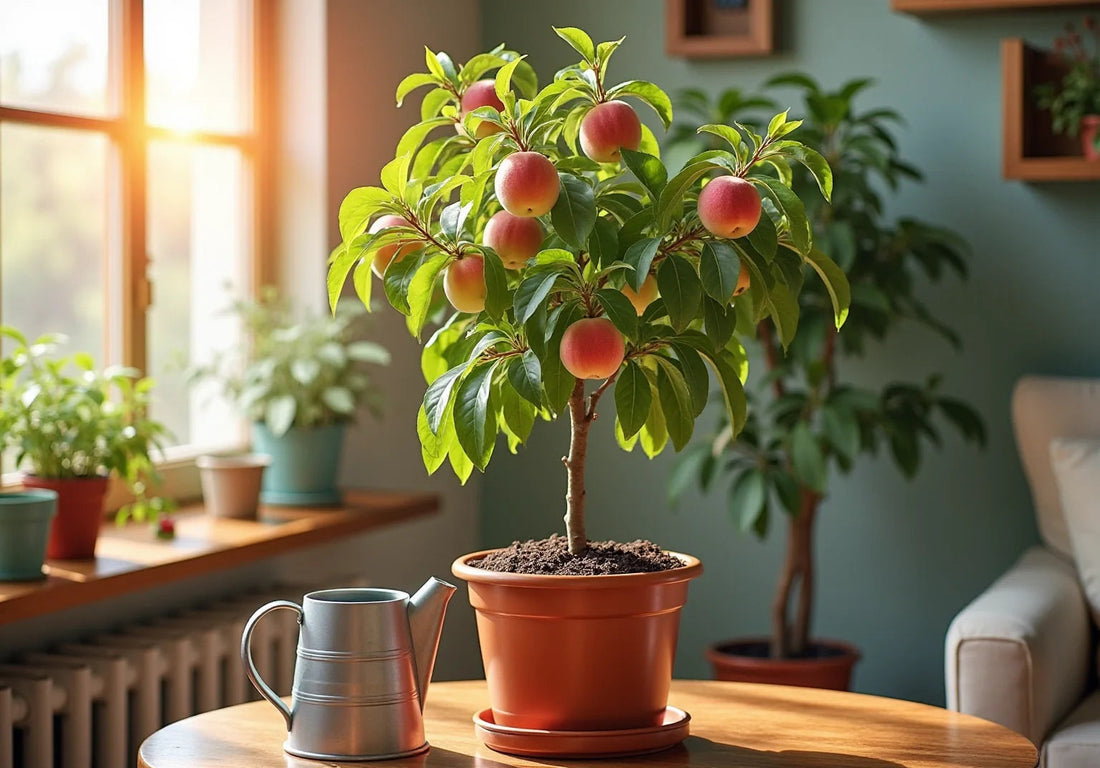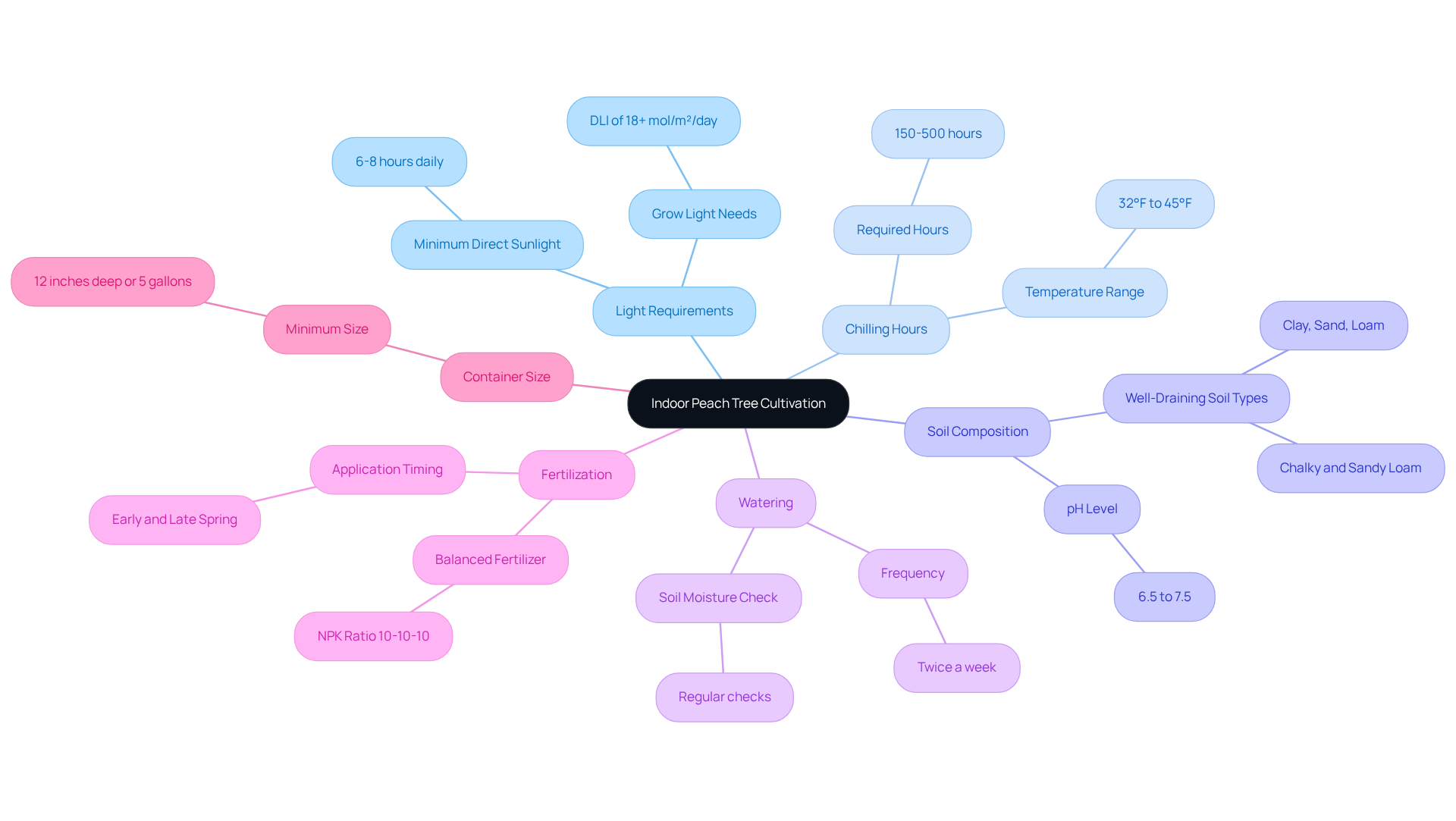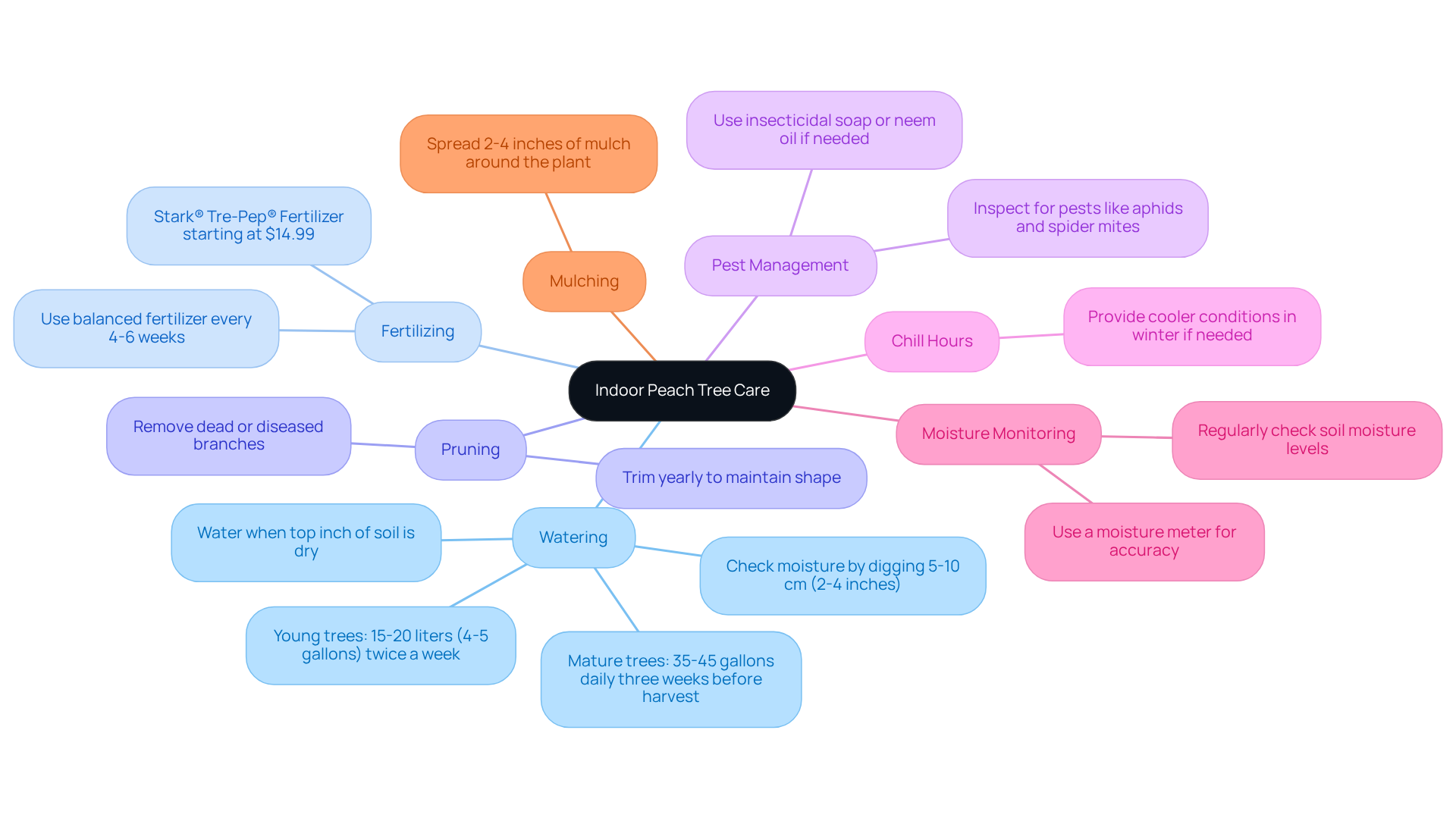
A Guide to Grow a Peach Tree Indoors Successfully
Share
Growing a peach tree indoors presents a unique opportunity to cultivate delicious fruit in the comfort of your home. With the right knowledge and care, anyone can transform their living space into a mini orchard, enjoying fresh peaches year-round. However, understanding the specific conditions these trees require is essential.
Factors such as:
- Light
- Temperature
- Soil
- Watering needs
play a crucial role in the success of indoor peach cultivation. This article will outline the essential steps to ensure a thriving indoor peach tree and provide insights on navigating common pitfalls that may hinder success.
Want to grow a Peach tree?
Explore Peach Trees for sale collection at Everglades Fearm - shipped directly from Florida.
1. Understand the Basics of Indoor Peach Tree Cultivation
To thrive, plants require specific conditions, especially when growing a peach tree indoors. They need a minimum of 6-8 hours of direct sunlight each day and a chilling period of 150-500 hours at temperatures ranging from 32°F to 45°F to bear fruit. Understanding these requirements is crucial for growing a peach tree indoors successfully. Additionally, selecting the right variety, such as dwarf or low-chill fruits, can significantly enhance your chances of success in growing a peach tree indoors.
Familiarizing yourself with the growth habits of these plants is essential. They require well-draining soil composed of clay, sand, loam, chalky, and sandy loam, along with consistent watering to maintain moisture levels. It is advisable to plant fruit-bearing varieties in containers that are at least 12 inches deep or 5 gallons in size to support their growth. Maintaining consistent moisture is vital; therefore, watering twice a week, especially during dry spells, is recommended. Regularly checking the soil moisture and ensuring proper drainage will create an optimal environment for growing a peach tree indoors, ultimately resulting in a fruitful harvest.
To encourage robust growth and fruit production, utilize a balanced fertilizer with NPK ratios such as 10-10-10. Additionally, consider the potential need for grow lights due to insufficient natural light in many homes, as this can further enhance growth and fruiting.

2. Establish Optimal Growing Conditions for Indoor Peaches
To establish optimal conditions for growing a peach tree indoors, start by choosing a location that receives ample sunlight, with a south-facing window being ideal. If natural light is insufficient, supplement with grow lights. It's essential to maintain indoor temperatures between 65°F and 75°F during the day, allowing for slightly cooler conditions at night. Furthermore, ensure humidity levels are maintained around 40-70% to prevent leaf drop and encourage robust development.
Regularly check the moisture content of the soil, ensuring it remains consistently damp but not saturated, which is crucial for promoting root health. Utilizing a well-draining potting mix will also help prevent root rot, an important consideration for your tree's longevity. For optimal development, it is important to maintain a soil pH of 6.0-6.5. To effectively manage humidity, consider using a hygrometer to monitor levels, and be vigilant for signs of low humidity, such as brown or dry leaves.
Aim to provide approximately an inch of water each week, particularly during the initial years, to keep your plant adequately hydrated. This consistent care will support the healthy growth of your indoor peach tree, which is essential for successfully growing a peach tree indoors and ensuring it thrives in your home environment.
3. Plant Your Peach Tree: Step-by-Step Instructions
-
When growing a peach tree indoors, choose the right container by selecting a pot that is at least 12-18 inches deep with drainage holes. This choice enables adequate root growth while preventing waterlogging, which is crucial for growing a peach tree indoors.
-
Prepare the soil for growing a peach tree indoors by utilizing a high-quality potting mix that offers good drainage. To enhance drainage further when growing a peach tree indoors, consider mixing in some perlite or sand, which can improve aeration and moisture retention.
-
Plant the Sapling: Carefully remove the peach plant from its nursery pot, loosening any tightly bound roots as part of growing a peach tree indoors. Ensure that when growing a peach tree indoors, you position the plant centrally in the new container, making sure that the root ball is level with the top of the potting mix. When growing a peach tree indoors, fill in around the roots with soil, pressing down lightly to eliminate air pockets and secure the plant in place.
-
When growing a peach tree indoors, make sure to water thoroughly after planting until the liquid drains from the bottom of the pot. This process helps settle the soil around the roots while growing a peach tree indoors. For container fruit plants, especially when growing a peach tree indoors, it is advisable to water every 5-7 days in spring and increase to every other day in summer to maintain optimal moisture levels.
-
Fertilize: Begin applying fertilizer to newly planted peach plants in March while growing a peach tree indoors. When growing a peach tree indoors, a liquid fertilizer should be applied every few weeks to promote healthy development and encourage fruit production, ensuring the plant receives essential nutrients.
-
Position the pot for growing a peach tree indoors in a location that receives ample sunlight, ideally near a south-facing window or under grow lights. For optimal growth and fruit production, growing a peach tree indoors can be challenging since peach plants thrive in full sun and require a minimum of six to eight hours of direct sunlight each day.
-
Chill Hours: Be mindful of the chilling requirements for your specific variety of fruit plant, especially when growing a peach tree indoors. For example, growing a peach tree indoors with the 'Bonanza' fruit cultivar requires 400 chilling hours, which are essential for successful fruiting and overall plant health.
-
When growing a peach tree indoors, plan to repot your fruit plant every two to three years to prevent it from becoming root-bound. This practice ensures continued health and productivity of the plant while effectively supporting growing a peach tree indoors, allowing it to thrive in its environment.

4. Maintain Your Indoor Peach Tree: Care and Maintenance Tips
To maintain your indoor peach tree, adhere to the following care tips:
-
Watering: Water your tree when the top inch of soil feels dry, ensuring the pot has adequate drainage to prevent root rot. Young peach plants generally need around 15-20 liters (4-5 gallons) of water each time they are irrigated, and they ought to be watered twice a week, particularly during dry periods. Mature plants, such as those involved in growing a peach tree indoors, may require up to 35-45 gallons daily during peak demand, especially three weeks prior to harvest.
-
Fertilizing: Apply a balanced fertilizer, such as Stark® Tre-Pep® Fertilizer starting at $14.99, every 4-6 weeks during the growing season (spring and summer) to supply essential nutrients. This practice is essential, as water is vital for optimal plant development and fruit production.
-
Pruning: Trim your plant yearly to preserve its form and promote new development. Remove any dead or diseased branches to promote overall health. Proper pruning techniques stimulate healthy growth and enhance fruit quality.
-
Pest Management: Regularly inspect your plant for pests such as aphids or spider mites. If needed, use insecticidal soap or neem oil as a natural remedy to manage infestations effectively.
-
Chill Hours: If your indoor environment does not provide sufficient chill hours for growing a peach tree indoors, consider placing the tree in a cooler area for a few weeks during winter to mimic the necessary conditions for dormancy. This step is crucial, as these fruits are sensitive to inadequate moisture and temperature changes, particularly three weeks prior to harvest.
-
Moisture Monitoring: Regularly check the moisture levels in the ground to prevent overwatering or underwatering. This practice is crucial for preserving the health of your fruit-bearing plant.
-
Mulching: Spread 2-4 inches of mulch around the plant to help conserve soil moisture, which is beneficial for maintaining hydration.

5. Troubleshoot Common Problems in Indoor Peach Tree Growth
Indoor fruiting plants can encounter various difficulties that influence their well-being and output. Understanding these common problems and their solutions is essential for successful indoor gardening.
A primary cause of leaf drop when growing a peach tree indoors is low humidity. Maintaining humidity levels between 40-60% is crucial. If humidity is insufficient, consider using a humidifier or placing pebble trays filled with water near the tree. Excessive watering can also lead to leaf drop; ensure the top inch of soil feels dry before watering again. Additionally, applying 1-2 inches of compost and mulch on top of the soil can help prevent underwatering issues.
Poor Fruit Production: Insufficient sunlight or inadequate chill hours can hinder fruit production. For growing a peach tree indoors, it is essential that the plants receive 6-8 hours of direct sunlight each day. If natural light is lacking, supplement it with grow lights positioned 12-18 inches above the plant. Furthermore, ensure the tree receives the necessary chilling period, which is essential for fruit set. Maintaining optimal daytime temperatures between 70°F to 80°F and nighttime temperatures between 60°F to 70°F is also crucial for healthy development.
Pest Infestations: Regular monitoring for pests is vital. Common pests include aphids and spider mites, which can cause yellowing leaves and reduced growth. If detected, treat infestations promptly with organic insecticides or natural remedies like horticultural oil. A strong jet of water can also help dislodge pests. It is recommended to check for pests weekly to catch any issues early.
Diseases: Fungal infections, such as fruit leaf curl and brown rot, can impact indoor plants. To reduce disease risk, ensure good air circulation around the plant and avoid overhead watering. If symptoms appear, promptly remove affected leaves and apply appropriate fungicides to prevent further spread. Additionally, be aware of peach tree rust, characterized by yellow spots on leaves, which can lead to leaf drop.
Nutrient Deficiencies: Yellowing leaves may indicate nutrient deficiencies, particularly nitrogen or iron. Use a balanced fertilizer, such as a 10-10-10 NPK ratio, every 4-6 weeks during the growing season to provide essential nutrients for healthy growth. Regular soil testing can help identify specific nutrient needs. It's also important to note that excessive nitrogen fertilizers can lead to healthy leaves but no fruit.
By addressing these typical concerns with proactive actions, indoor fruit plant enthusiasts can nurture healthy, productive specimens, such as growing a peach tree indoors, that flourish in their home settings. Additionally, pruning Elberta peach trees in late winter or early spring is recommended for optimal growth.

Conclusion
Growing a peach tree indoors can be a rewarding endeavor, offering the delight of fresh fruit right from the comfort of home. By understanding the specific requirements for light, temperature, and soil, as well as employing the right care techniques, anyone can cultivate a flourishing indoor peach tree. The journey from choosing the right variety to ensuring optimal growing conditions plays a crucial role in the success of this project.
Key insights include:
- The importance of providing adequate sunlight for 6-8 hours daily
- Maintaining appropriate humidity levels
- Ensuring consistent watering and fertilization
Troubleshooting common problems such as leaf drop or poor fruit production can significantly enhance the overall health and productivity of the tree. Regular monitoring and proactive care are essential components of this indoor gardening experience.
Ultimately, the process of growing a peach tree indoors not only brings the joy of nurturing a plant but also the satisfaction of harvesting homegrown fruit. Embracing these practices and being attentive to the tree's needs can lead to a fruitful and fulfilling indoor gardening adventure. Start today, and transform your living space into a vibrant oasis of fresh peaches!
Transform Your Home into a Peach Paradise!
Start your indoor gardening adventure today with Everglades Farm's premium peach trees and expert tips.
🛒 Buy Juicy Peach Mango Tree
Frequently Asked Questions
What are the basic requirements for growing a peach tree indoors?
Peach trees need a minimum of 6-8 hours of direct sunlight daily and a chilling period of 150-500 hours at temperatures between 32°F and 45°F to bear fruit.
What types of peach tree varieties are suitable for indoor cultivation?
Dwarf or low-chill fruit varieties are recommended for growing peach trees indoors, as they significantly enhance the chances of success.
What type of soil is best for indoor peach trees?
Indoor peach trees require well-draining soil composed of clay, sand, loam, chalky, and sandy loam.
How often should I water my indoor peach tree?
It is advisable to water the peach tree twice a week, especially during dry spells, while regularly checking the soil moisture.
What size container should I use for planting an indoor peach tree?
Plant fruit-bearing varieties in containers that are at least 12 inches deep or 5 gallons in size to support their growth.
What type of fertilizer should I use for indoor peach trees?
A balanced fertilizer with NPK ratios such as 10-10-10 is recommended to encourage robust growth and fruit production.
How can I supplement light for my indoor peach tree?
If natural light is insufficient, consider using grow lights to enhance growth and fruiting.
What are the optimal indoor temperature conditions for growing peach trees?
Maintain indoor temperatures between 65°F and 75°F during the day, allowing for slightly cooler conditions at night.
What humidity levels are ideal for indoor peach trees?
Humidity levels should be maintained around 40-70% to prevent leaf drop and encourage robust development.
How can I monitor and manage humidity for my indoor peach tree?
Use a hygrometer to monitor humidity levels and watch for signs of low humidity, such as brown or dry leaves.
How much water does an indoor peach tree need weekly?
Aim to provide approximately an inch of water each week, particularly during the initial years, to keep the plant adequately hydrated.
What soil pH is optimal for indoor peach tree growth?
A soil pH of 6.0-6.5 is ideal for the optimal development of indoor peach trees.


